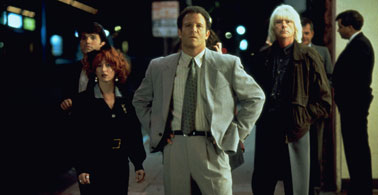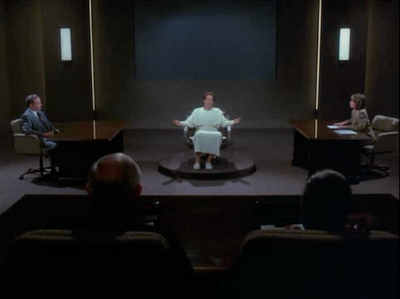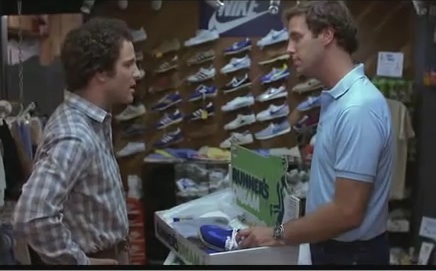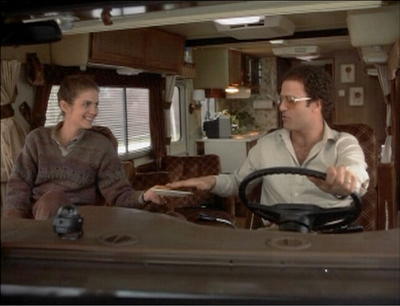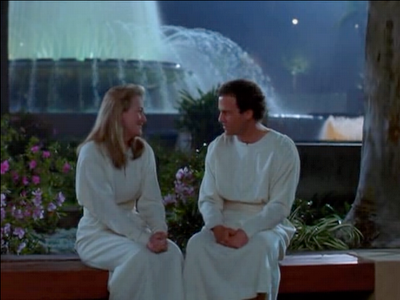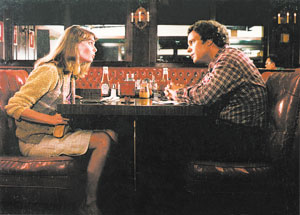The following was commissioned in 1999 by Written By, the magazine of the Writers Guild, which decided not to run it because Brooks’s agent refused to let me see The Muse in advance for this article unless a “cover story” was promised. Written By, to its credit, refuses to make deals of this kind. So the magazine paid me for the article and didn’t run it, which I hope made Brooks’s agent properly proud of his efforts. — J.R.
You may recall him as the wealthy convict in Out of Sight, or, prior to that, as Cybill Shepherd’s wisecracking cohort at the campaign headquarters in Taxi Driver, as Holly Hunter’s best friend in Broadcast News, or as the neurotic Hollywood producer in I’ll Do Anything. Maybe, if you’re luckier, you’ve seen his five underrated and highly durable comedies — Real Life (1979), Modern Romance (1981), Lost in America (1985), Defending Your Life (1991), and Mother (1996) — which will be succeeded later this year by The Muse.
Albert Brooks has so far taken solo writing credit only on Defending Your Life — sharing script credit with TV comedy writer Monica Johnson on the other four (as well as on The Scout, a disappointing 1994 baseball movie he didn’t direct), and also with Harry Shearer on Real Life, the first and probably the funniest of the lot. But the stamp of his comic persona is so central to all five movies that none of them would be imaginable with anyone else as the lead actor. And when it comes separating his work as a writer from his persona as an actor and his style as a director, some recognition of how all three functions overlap becomes necessary — as it does for most other comics who shoulder these triple duties, ranging from Charlie Chaplin to Jerry Lewis and from Elaine May to Mel Brooks.
Born in Los Angeles with the name Albert Einstein, Brooks was the son of radio comic Harry Einstein, and members of his show-biz family occasionally crop up in his films (most notably Bob Einstein as a sporting goods sales-man in Modern Romance; see still below). He started out as a standup comic after dropping out of college in 1967, and began working for TV in the late 60s — writing for the ill-fated Turn-On (an edgy Laugh-In spinoff) in 1968 and, the following year, making the first of his nine appearances on The Dean Martin Show. His first forays into filmmaking were all done for TV in the 70s — something for PBS called The Great American Dream Machine that adapted an article he had previously published in Esquire (“Albert Brooks’ Famous School for Comedians,” 1971) followed by six short films for Saturday Night Live, only one of which I’ve seen — an account of a coronary bypass operation done in the same pseudo-documentary style he would later perfect in Real Life. During the same decade, he appeared frequently on The Ed Sullivan Show, The Steve Allen Show, The Merv Griffin Show, and The Tonight Show with Johnny Carson, and produced two eccentric comedy albums, Comedy Minus One (1973) and A Star is Bought (1975), the latter of which also anticipated RealLife in certain respects. All this work undoubtedly played a role in shaping the persona that his later movies were built around, defining a process in which writing and performing became two sides of the same coin.
For a few weeks in 1973, while I was living in Paris, I was making daily trips to the office of the great writer-director-comic Jacques Tati, to work as “script consultant” on a feature that he never wound up making. In fact, my work was serving as his audience and his work was a kind of writing he performed with his voice and body — sketching out sequences in which he played every character and prop and articulated every line and sound-effect. As a variation on E.M. Forster’s writerly question, “How do I know what I mean until I see what I say?”, Tati’s multifaceted improvs were a way of saying, “How do I know what I think until I see what I do?” And thanks to what his improvs produced, his question was every bit as writerly as Forster’s, even if his pen was his body and his paper was the space around him.
According to Orson Welles, even Charles Dickens was an actor — “and he was not a writer who acted, he was an actor who wrote….Certainly all the great dramatists have been actors of one sort or another. And all great directors and author-directors are actors.” This was forcibly brought home to me recently when I started comparing the scripts for Modern Romance, Lost in America, and Defending Your Life with the finished films. Though the characters are the same and the plot and situations roughly equivalent — even though some of the scenes appear in different settings and in a different order — the precise dialogue rarely matches, apparently because Brooks as a director and actor compulsively revises whatever he and/or Johnson have written. Given the precise constructions of both the scripts and the films, one can’t say that these revisions are always improvements, although sometimes they’re much funnier. (Example: when the hero of the purgatorial fantasy Defending Your Life sees one of his previous incarnations in hologram form in the Past Lives Pavilion — a fleeing African native — and is asked by his girlfriend [Meryl Streep] in the adjoining booth, “Who are you?”, his scripted response is, “I’m the guy in The Gods Must Be Crazy“; in the movie, it’s simply, “Dinner.”) Basically they’re intricate reworkings that translate the words on the page into dramatic realizations where settings, performance styles, and conditions of shooting all undoubtedly contribute to the alterations.
Brooks has never established himself in the public mind the way that Woody Allen has because his vision is a lot more subtle and complex. You can’t demonstrate his brilliance by quoting his dialogue, and you can’t even say he’s funnier than Allen if you’re measuring strictly by the number of laughs. Nevertheless, I think he can be regarded as the best comic writer-director-actor working in America at present — certainly the most thoughtful and original, and the one who has the most to say about who we are.
Like Allen, Brooks sculpts his comic vision around his own persona, and partially invites the audience to identify with that persona; where he differs most crucially from Allen in the rigorous critical and analytical distance he is able to sustain in relation to that identification. While Brooks’s heroes tend to be as provincial as Allen’s — as tied to the cultural limitations of southern California as Allen’s heroes are to those of New York — the worlds they in-habit are not at all similar; where Allen seeks to glamorize, Brooks revels exclusively in the banal and everyday. When Allen uncharacteristically turns up in Los Angeles in Annie Hall, or in Venice and Paris in Everyone Says I Love You, the cities we see are a New Yorker’s touristic versions of them. But when Brooks turns up in Phoenix, Arizona in Real Life, or in Las Vegas and less urban parts of the American southwest in Lost in America, these areas aren’t simply depicted from a southern California perspective; they’re uncanny approximations of the American experience as a whole.
In short, Brooks as an artist is able to break away from his urban and ethnic roots and see the world outside with some degree of detachment and lucidity, whereas Allen’s artistry, like his persona, is virtually defined by his in-ability or disinclination to do that. It’s theoretically possible to imagine and even visualize the comic grotesqueness of one of Brooks’s unhappy heroes going to India and working with Mother Teresa; when Allen postulates the heroine of Alice (Mia Farrow) doing precisely that, he simply borrows a clip from a Louis Malle documentary to fill in the blanks. At the very least Brooks would explore the idea; at most Allen can only entertain it.
From the very titles of Brooks’s five features, we know that he’s a serious and honest writer, because each one is a precise and accurate indication of what the movie is about. For all their fascinating differences, all these movies are contemporary satires, philosophical parables, and highly realistic comedies about self-defeating behavior, and all of them have something to do with the role played by movies in messing up people’s heads and lives. They also all have a lot to do with the inner-directed, self-centered, new age sensibility that overtook much of affluent America in the 70s once the political and collective consciousness of the 60s began to wane. This shift in national consciousness, comparable to the cold war paranoia of the 40s, 50s, and 60s that overtook the political and collective consciousness of the 30s, is a central part of American history over the past quarter of a century, and Brooks is the most lucid chronicler we have of this ideological change — above all in Lost in America, where it is explicitly shown in relation to the 60s countercultural dreams represented by Easy Rider.
Brooks is the flawed, image-conscious, west-coast hero in each case — a filmmaker and comic in Real Life, a film editor in Modern Romance, advertising executives in Lost in America and Defending Your Life, and a SF writer in Mother — and acute self-consciousness is a problem that all of these heroes engender and encounter. Interestingly enough, the brassy show-biz type Brooks plays in Real Life — so close to Brooks’s own public persona that he’s called Albert Brooks — professes to be impervious to all this. Shooting an extended documentary about the life of a “typical” family in the style of the 1973 TV series An American Family, he claims that anything the family does in front of the camera is “right,” without admitting that the acute self-consciousness created by his film and camera crew ultimately has more to do with movies than with real life. A related but different sort of obsessive neurosis plagues the self-absorbed editor in Modern Romance, consumed by alternating bouts of jealousy and romantic fantasy that make him incapable of either ending or revitalizing a long-term relationship. Like the hero of Real Life, he never seems to know when to leave well enough alone; and while his girlfriend (Kathryn Harrold) ultimately seems as trapped in their unresolved relationship as he is, she’s the main one dealing with the self-consciousness and embarrassment his behavior creates.
The Real Life director eventually goes berserk when he loses control over both the family being filmed and his movie, and sets fire to his rented house in order to produce a spectacular finish. By contrast, the Modern Romance editor may behave like an infant with his girlfriend, but he never loses his professional cool — which he needs in servicing the demands of a director of a routine, low- budget SF film (played by writer-director James L. Brooks) who is every bit as obsessive about his silly picture as the editor is about his relationship. Both characters are compulsive revisers of mundane, imperfect “material” that seems impossible to redeem, much less improve. (As a suggestive portrait of the obsessional and professional aspects of a control freak, Modern Romance significantly prompted a fan letter from Stanley Kubrick — a filmmaker whose reclusive habits in relation to the press have been echoed in some ways by Brooks.)
The yuppie admen in the next two pictures — a husband in Lost in America who quits his job and persuades his wife to do the same so that they can “rediscover” America and themselves, and a divorced bachelor in Defending Your Life who dies and finds himself in a secular, new-age purgatory called Judgment City, where he’s forced to re-examine his life in the form of film clips — may seem slightly less demented, but they’re equally victims of impulses and images that belong to their profession. They’re constantly trying to sell themselves (and others) concepts that might redeem their unfulfilled lives, and much as “reality” and “romance” are the key concepts of the first two Brooks movies, “dropping out” and “fear” are the operative concepts in the second two. All four of these concepts are combined in Mother, in which a recently divorced SF writer decides to move back in with his mother (Debbie Reynolds) in order to sort out why he can’t sustain a relationship. And the therapeutic mode of both Defending Your Life and Mother suggests that, far from being content to capitalize on his heroes’ woes, as Allen invariably does, he’s determined both to understand and to do something about them.
While his first three features all end with ironic printed epilogues explaining what happened to the characters afterward, in each case implying a psychic impasse and compulsive loop in the hero’s behavior, the two most recent features end with hyperbolic, last-minute happy endings that suggest both therapeutic self-fulfillment and the triumph of Hollywood romantic fantasy. (If the elation of these endings seems somewhat willed and rhetorical, this may be because the neurosis in these films is so convincing and omnipresent that we can’t readily imagine any instant resolutions.)
In one way or another, all of Brooks’s features are structured in relation to other movies or TV series. Real Life is inspired by An American Family; the action of Modern Romance is shaped by the SF movie that Brooks’s hero is editing; the action of Lost in America is inspired by the hero’s memory of Easy Rider. In Defending Your Life, where portions of the hero’s life are viewed and critiqued like film rushes, two classic films seem to function as reference points — Lang’s Liliom (an afterlife screening-room tribunal) and Lubitsch’s Heaven Can Wait (a questionable life is reviewed to determine where the deceased should proceed next). In Mother, the main reference point is The Graduate, signaled on the soundtrack by a revamping of a pop song closely associated with that picture, “Mrs. Robinson”. (A touchstone in both triumphant Jewish assimilation and what might be termed “California dreaming,” The Graduate plays a comparable pivotal role in two comic features of Elaine May, The Heartbreak Kid and Ishtar.) As the new lyrics, “Mrs. Henderson,” imply, Mother proposes a kind of inversion of the theme of The Graduate — a return to family and roots as a source for liberation. Working with what you have is the motto of Brooks’s work, and the key to his special brand of comic realism.
(previously unpublished; written in 1999)

